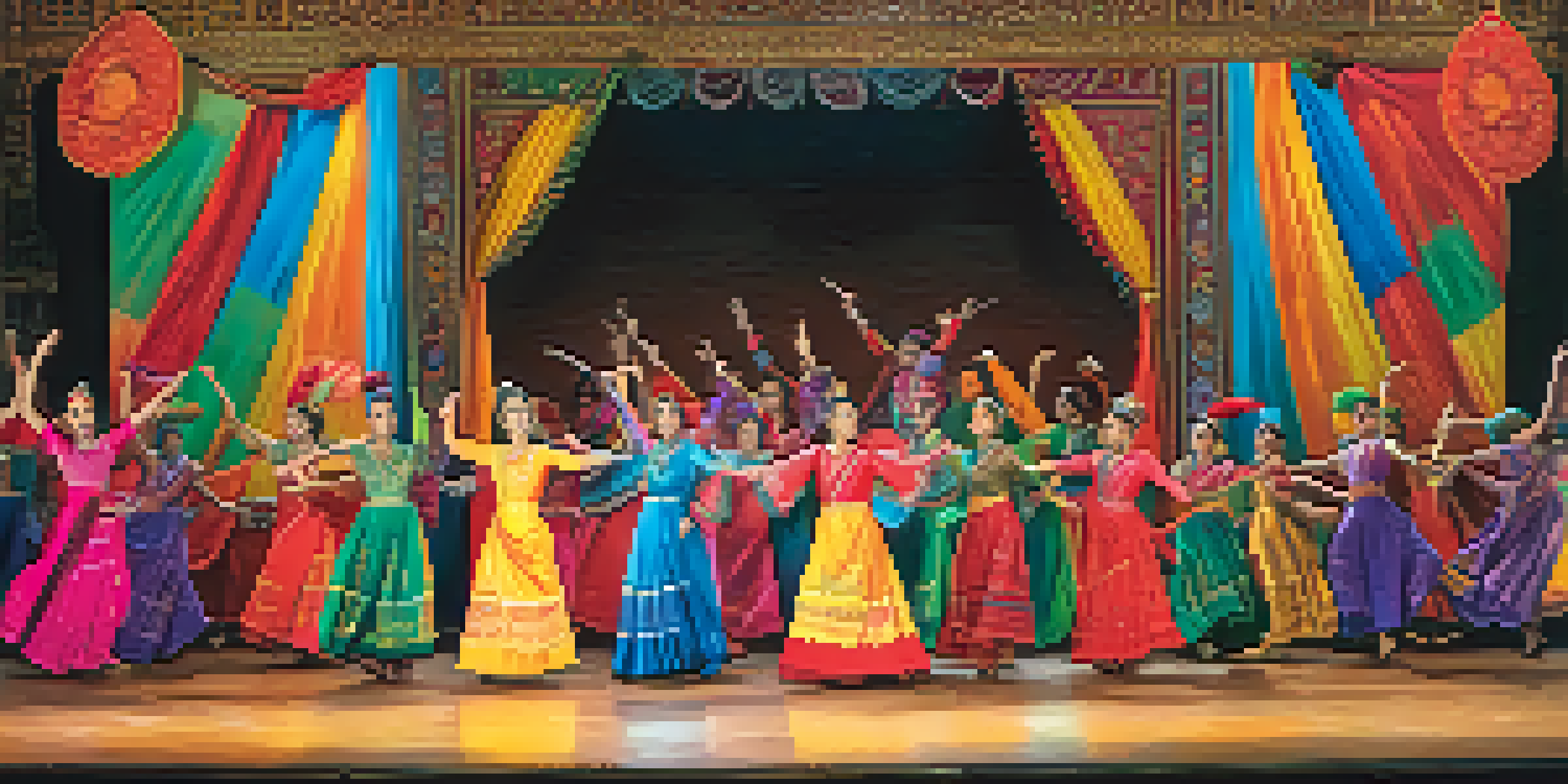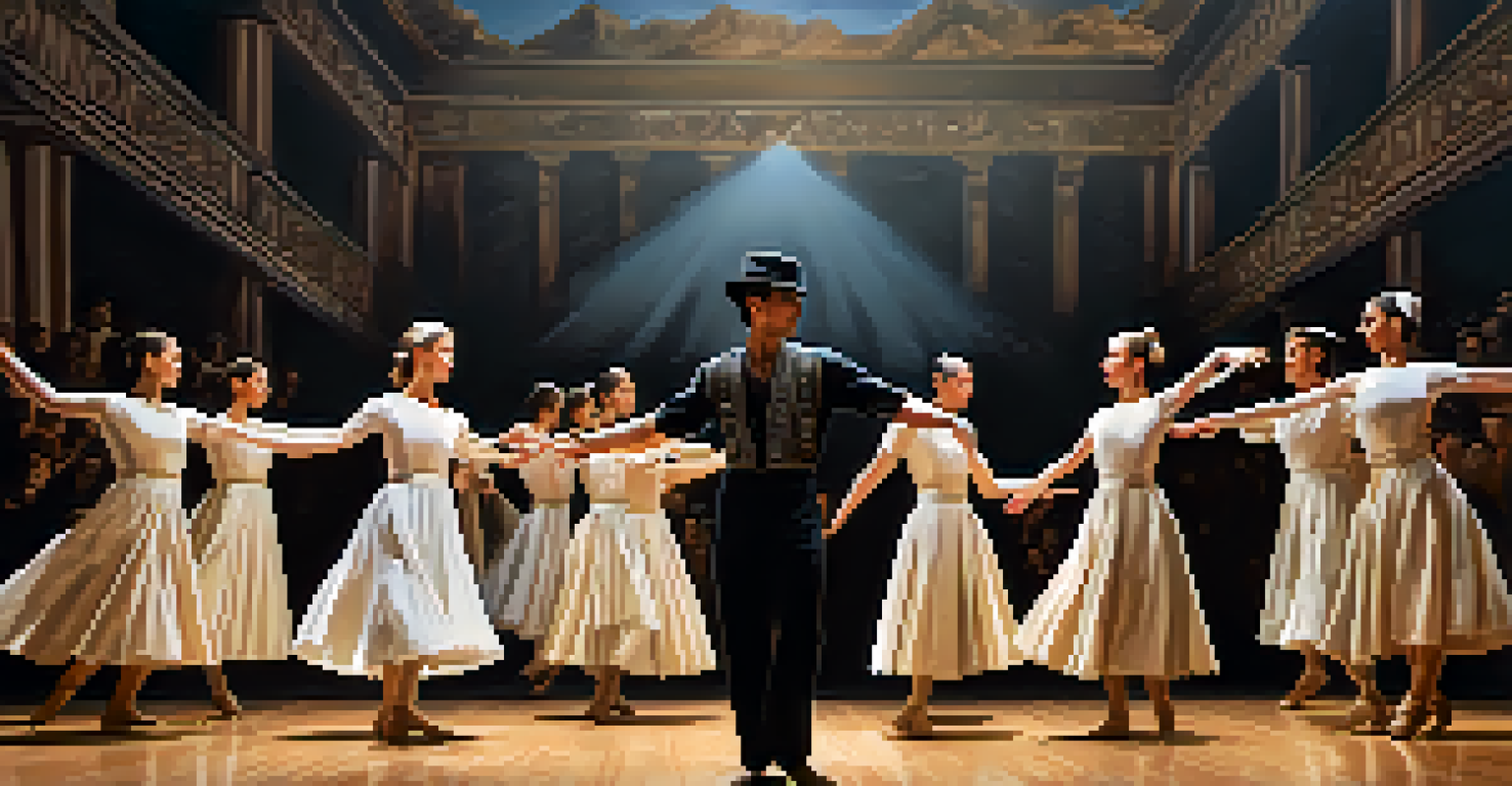Dance as a Vehicle for Reinterpreting History

Understanding Dance as a Historical Narrative Tool
Dance has long been a form of storytelling, but its role in narrating history is particularly profound. Through movement, dancers convey emotions and themes that resonate with cultural experiences, allowing audiences to connect deeply with the past. For example, traditional folk dances often depict historical events, celebrating victories or mourning losses, making history tangible and relatable.
Dance is the hidden language of the soul.
Moreover, dance transcends language barriers, offering a universal means of communication. While words can sometimes fail to capture the essence of historical events, the physicality of dance can evoke a visceral understanding. This is evident in performances that reinterpret significant moments, turning abstract concepts into expressive movements that speak to the heart.
In essence, dance serves as a dynamic vessel for historical re-examination, inviting audiences to engage with narratives in a way that is both educational and emotionally resonant. By witnessing these performances, we not only learn about history but also feel its impact, making it relevant to our current lives.
Cultural Dance Forms and Their Historical Significance
Every culture has its unique dance forms, each rich with historical significance. For instance, the tango, originating from the streets of Argentina, embodies the struggles and passions of immigrant communities. Through its intricate movements, dancers express stories of love, loss, and resilience, showcasing how cultural history is woven into the fabric of dance.

Similarly, African dance forms often celebrate ancestral heritage, rituals, and communal experiences. These dances are not just performances; they are cultural ceremonies that honor history and identity. By participating in or observing these dances, individuals connect with their roots and gain insights into the historical contexts that shaped them.
Dance as a Storytelling Medium
Dance serves as a profound tool for narrating history, allowing audiences to connect emotionally with cultural experiences.
Thus, cultural dance forms serve as living archives of history, preserving and passing down stories across generations. They remind us that history is not just about dates and events, but also about the people and cultures that shaped those moments.
Dance Theater: Bridging History and Contemporary Issues
Dance theater has emerged as a powerful medium for exploring historical narratives while addressing contemporary issues. Choreographers often blend traditional dance with modern elements to create thought-provoking performances that resonate with today’s audience. For example, works that address themes of colonization or civil rights use dance to highlight injustices and provoke conversation.
The dance is a poem of which each movement is a word.
This fusion of past and present allows audiences to reflect on how historical events shape current societal challenges. When dancers embody historical figures or events, they challenge us to reconsider our understanding of history and its implications. By presenting these themes in a visually compelling way, dance theater can inspire action and empathy.
In this sense, dance becomes a catalyst for change, encouraging viewers to engage with history not just as spectators but as active participants in shaping the future. The dialogue between history and contemporary issues through dance creates a space for reflection, learning, and growth.
Reinterpreting Historical Events Through Dance
Many choreographers take the bold step of reinterpreting historical events, allowing for a fresh perspective on well-known narratives. For instance, a dance piece that revisits a historical battle might focus on the emotional experiences of individuals rather than the conflict itself. This shift in focus can humanize history, making it more relatable and impactful.
Such reinterpretations challenge traditional narratives and provoke critical thinking about the past. When modern choreography is applied to events like revolutions or movements for equality, it can highlight the ongoing relevance of these struggles. Audiences may be prompted to reflect on how these historical events continue to influence our world today.
Cultural Dance Preserves History
Unique dance forms embody historical significance, acting as living archives that pass down stories through generations.
By reimagining history through dance, artists invite us to question established narratives and explore new meanings. This innovative approach not only honors the past but also encourages us to engage actively with our collective history.
The Role of Dance in Social Movements
Dance has often played a crucial role in social movements, serving as a means of expression and solidarity. Choreographed movements can become symbols of resistance, with dancers using their art to raise awareness about social injustices. For example, during the Civil Rights Movement in the United States, dance was employed to unify communities and amplify messages of freedom and equality.
In contemporary contexts, dance continues to be a powerful tool for activism. Flash mobs and public performances can draw attention to critical issues, using the energy of collective movement to inspire change. These performances often create a sense of community, rallying individuals around a shared cause and fostering a spirit of collaboration.
Ultimately, the intersection of dance and social movements illustrates how art can be a force for transformation. By harnessing the power of dance, activists can communicate their messages in a way that is both impactful and memorable.
Dance as a Reflection of Identity and Memory
Dance is inherently tied to identity, reflecting personal and collective experiences. For many, engaging in dance can be a way to connect with one’s heritage and preserve cultural memory. For instance, traditional dances passed down through generations serve as a means of keeping history alive, allowing individuals to celebrate their roots.
Moreover, the act of dancing can evoke memories, creating a sense of nostalgia that connects us to the past. When people participate in dances from their childhood or cultural celebrations, they often find themselves reliving moments that shaped their identities. This emotional connection reinforces the idea that dance is not just an art form but a vessel for personal and shared histories.
Dance and Social Change
Dance plays a crucial role in social movements, using choreography as a means of expression and solidarity to inspire change.
By exploring identity through dance, individuals can express their unique stories while also acknowledging the broader historical narratives that influence them. This interplay between personal experience and historical context enriches our understanding of both dance and history.
The Future of Dance as a Historical Medium
As society continues to evolve, so does the role of dance in interpreting history. With advancements in technology and multimedia, choreographers are experimenting with new ways to tell historical stories. Virtual reality performances, for example, can immerse audiences in historical contexts, allowing them to experience dance in a completely new dimension.
Additionally, the rise of social media has made dance more accessible, enabling diverse voices to share their interpretations of history. Platforms like TikTok and Instagram allow dancers to reach global audiences, fostering a vibrant exchange of ideas and styles. This democratization of dance can lead to fresh perspectives and innovative storytelling.

Looking ahead, the future of dance as a historical medium is bright. As artists continue to push boundaries and explore new narratives, we can expect to see even more dynamic and thought-provoking interpretations of history through dance.